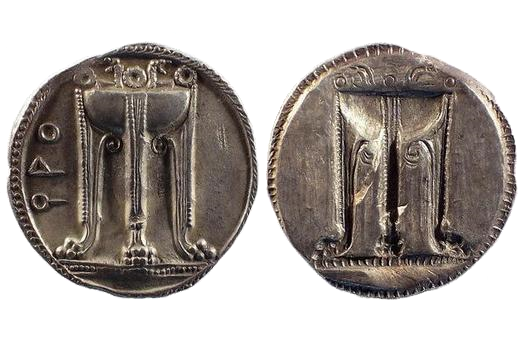
about ancient nomos
Ancient Nomos Art is a museum of galleries exhibiting ancient coins and ancient mint maps. The coin gallery displays the diverse art and history of hand-crafted ancient Greek, Roman, Byzantine, Persian and Medieval coinage. The ancient mints mapping gallery features Greek, Roman, Byzantine, Asia Minor and Medieval mint city regions and territories. Visitor's are welcome to explore, study and enjoy Ancient Nomos Art.

Greek, Bruttium – 520 BC
Kroton
From Ancient Galleries

Obverse: Three handled Tripod with Lion's feet and volutes between central leg, set on exergal dots between two lines. Two Serpents emerging from the bowl.
Reverse: Incuse Tripod with Serpents (no legend) all around incuse detate border.
LEGEND SYMBOLS
Obv. Three handled tripod with volutes between central leg. Tripod stands with legs terminating in lion’s feet and set on exergual dots between two plain lines. Two serpents emerging from the bowl at top. ϘPO ethnic on field to left. Rev. Incuse tripod with serpents (without legend), all around incuse dentate border.
The Magna Graecia city of Kroton is located along the eastern coast of Calabria, Italy. Kroton was established by colonists from mainland Greece during the 8th century BC. It is believed that the Priestess Pythia, seated in her sacred Apollo tripos (tripod), informed Myskellos to follow the Oracle of Delphi directive and lead a group of Achaean settlers to their new city. The tripod’s significance as sacred instrument of mystic prophecy and Delphic worship made it the ideal civic symbol and emblem of Kroton. Small tripods were even known to be prizes given to winning Krotonites during ancient games and festivals. Kroton was among the first in Magna Graecia to produce coinage in southern Italy starting in the mid-6th century. The above example is an early archaic “incuse” style coin struck using the Achaian weight standard. The silver stater’s obverse depicts the three-legged tripod stand made of bronze with three ornamented lion’s feet. The bowl shape is formed by three conjoined volutes, with three rings at the top to serve as handles. The tripod bowl rests within the stand and is often also bronze though can be made of ceramic, marble and wood. Two snakes are seen emerging upright from the tripod bowl, perhaps as the symbolic twin guardian serpents of Gaia, before Apollo expelled the animals in favor of Pythia. Exergual dots between two plain base lines give support to the tripod. The Greek ethnic legend ϘPO are the abbreviated first three letters of Kroton. The coins reverse image mimics the obverse by the use of an incuse engraved die with matching tripod image with two serpents. The incuse reverse die is characteristic of archaic coinage and is thought to be an early die engravers technique and strategy that enhanced the flow of flan metal into the “favored” obverse details when striking (see also Kroton Incuse). Kroton’s currency continued for several more centuries and was always characterized by the tripod image.
SPECIAL FEATURE EXHIBIT
The ANAM Special Features gallery examines how the ancient Kroton silver stater Celator’s (die engravers) used a cleaver design distortion technique to create an ideal two dimensional (2-D) sacred Lebes tripod image symbol by rotating the rear two legs 30o forward. To view the Special Features ancient Kroton Celator’s cleaver design distortion, please use the following link: Kroton Tripod Distortion Special Feature Exhibit
DOCUMENTATION
Value: Stater. Metal: AR Silver. Weight: 8.39 grams. Mint: Kroton. Date: circa 520 BC.
Attribution: SNG ANS 227-234. SNG Cop. 1336. Gorini 2. SNG Lockett 597. Historia Numorum Italy 2075. Sternberg 1988, 19; Weber, Plate 39, 997.
Legend, Documentation and Attribution
